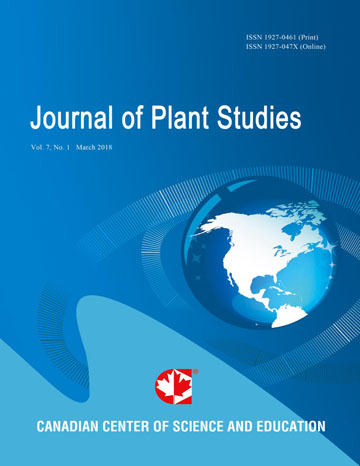Molecular Characterization of Solanum Species (Solanum aethiopicum complex; Solanum macrocarpon and Solanum anguivi) Using Multiplex RAPD primers
- C. U. Aguoru
- L. O. Omoigui
- J. O. Olasan
Abstract
Genetic diversity of S. aethiopicum complex, S. macrocarpon and S. anguivi was investigated using molecular approach. Seeds were randomly secured across north central locations in Nigeria and planted. Nine (9) oligonucleotide primers were initially screened for their polymorphism from where five (5) polymorphic primers were selected. A total of twenty five (25) accessions were studied. DNA was extracted from each accession using FTA PlantSaver card method following standard protocol (Whatman®, 2014). Amplification of the extracted DNA was performed on a thermal cycler (Applied Biosystem in Life Technology version 2720) through the use of a multiplex of OPP-11, B-18, OPU-13 and OPU-15 primers. A total of fifty (50) PCR reactions were carried out (25 separate reactions each for OPQ-07 primer and Multiplex primer). Amplified products were resolved on agarose gel electrophoresis. DNA band profiles generated by primers were manually scored (using zero (0) for absence of band and one (1) for presence of band) to generate binary matrices for the two band profiles. Statistical analysis was performed using the SPSS (Statistical Package for Social Scientists) software (20.0 Version). Hierarchical cluster analysis of all the individual accessions was done using the Average Linkage “Between Group” Method based on Euclidean Distance measurement, to generate two dendrograms, one for each primer set. Results revealed the polymorphic strength of each primer sets as 45%. Each primer yielded an average of 4.5 polymorphic loci per 10 DNA bands. Dendrograms showed high level of intraspecific and interspecific variability and similarities among the accessions whose clustering patterns were both location dependent and location independent. Based on the clustering patterns, there were sharp genetic dissimilarities between S. aethiopicum gilo, S. anguivi medium, S. anguivi tiny, striped gilo-kumba complex and S. macrocarpon on one hand, and similarities among the species on the other hand indicating a common ancestral origin. Having established a substantial level of variability in this study, breeding efforts of varieties may be facilitated for improvement programme and this can also be used as a template for further taxonomic studies of the unidentified seeds and fruits showing divergent characters.
- Full Text:
 PDF
PDF
- DOI:10.5539/jps.v4n1p27
Index
- AGRICOLA
- CAB Abstracts
- CABI
- CAS (American Chemical Society)
- CNKI Scholar
- Elektronische Zeitschriftenbibliothek (EZB)
- Excellence in Research for Australia (ERA)
- Google Scholar
- JournalTOCs
- Mendeley
- Open policy finder
- Scilit
- Standard Periodical Directory
- Technische Informationsbibliothek (TIB)
- WorldCat
Contact
- Joan LeeEditorial Assistant
- jps@ccsenet.org
